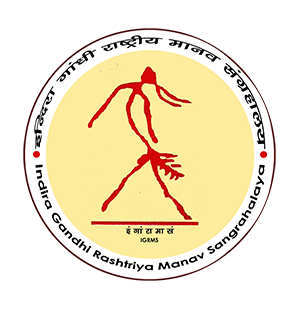कोठा घर
ग्रांम: मीठा आम
जिला: बांकुरा, पश्चिम बंगाल
संकलन वर्ष : 2015
पश्चिम बंगाल, बांकुरा से भूमिज का एक पारंपरिक घर भूमिज मुख्यतः पश्चिम बंगाल, झारखंड, ओडिशा, असम और त्रिपुरा में वितरित सबसे बड़े जनजातीय समुदायों में से एक है। व्युत्पत्ति के अनुसार, भूमिज शब्द ‘भू’ शब्द से बना है, जिसका अर्थ है ‘पृथ्वी’, वे स्वयं को धरती का पुत्र कहते हैं। पश्चिम बंगाल में वे बांकुरा, पुरूलिया, मिदनापुर और 24 परगना जिलों में केन्द्रित हैं, वे भूमिज भाषी हैं, लेकिन उनकी मातृभाषा पूरी तरह से बंगाली से प्रभावित है। उनका मुख्य व्यवसाय कृषि है और मछली पकड़ने तथा शिकार उनके द्वितीयक व सहायक व्यवसाय हैं। ये लोग वन आच्छादित क्षेत्रों या बीहड़ों में रहना पसंद करते हैं।
एक खास भूमिज घर की अधोसंरचना आयताकार होती है जोकि भीतर से ठंडा रखने के लिये मिट्टी की मोटी परतों वाली दीवार पर खड़ी होती है। घर की संरचना मुख्य रूप से दो मंजिला हैं, जो चार ढलानों वाली छत पर ताड़ की लकड़ी और मोटे बांस के फ्रेम से बना है। मकान का आधार जमीन से डेढ फुट ऊंचा है। घर के ऊपरी ढांचे को लकड़ी के तख्तों से बनाया जाता है, जो बीम के आर-पार समान्तर है, जिससे ऊपरी कक्ष के फर्श को मजबूत किया जा सके। घर में एक खुला प्रांगण है, जिसे उठान कहा जाता है जो मिट्टी की मोटी मगर कम ऊंचाई की उठी हुई चार दीवारी से घिरा हुआ है। चार दीवारी के ऊपरी हिससे को बारिश व सूरज के प्रत्यक्ष प्रदर्शन को रोकने के लिये दोनों तरफ से छप्पर से ढक दिया गया है। इसमें पूर्व की ओर मुख करके सदर नामक एक प्रवेश द्वार है। घर में दो कमरे हैं, एक जमीन पर एवं दूसरा उसके ऊपर। ऊपर वाले कमरे के लिये मिट्टी से निर्मित सीढियां हैं। इसमें घर के सामने एक छोटा ढका हुआ बरामदा है जिसे कभी-कभी रसोई के रूप में भी उपयोग किया जाता है। रसोई को रान्नाघर के रूप में जानते हैं, जबकि वे ज्यादातर स्थायी रूप से आंगन में स्थित रसोई का उपयोग करते हैं। मवेशी शेड जो गौशाला/गोयालघर नाम से जाने जाते एवं अन्न भंडार जो स्थानीय रूप से मराई के रूप में जाने जाते हैं, तथा धान कटाई के लिये शेड, ढेंकी शल मकान के अंदर स्थित हैं। मवेशी शेड, गोआलघर में मिट्टी के कुछ बड़े टीले गाय को चारा देने का पात्र होता हैं, जिसे सामान्यतः जमीन की सतह पर थोड़ा गड़ाया जाता है। मवेशी शेड के पास शीर्ष पर एक गोलाकार छप्पर के साथ मुडे़ हुये पुआल की रस्सियों से बना एक अन्न भंडार (मराई) है, जिसमें एक परिवार के लिये एक फ़सल से दूसरी फ़सल तक पर्याप्त मात्रा में धान रखते हैं। भूमिज अपने घर को सुंदरता की दृष्टि से साफ़-सुथरा रखते हैं। वे दीवारों पर मिट्टी, गोबर व धान की भूसी से प्लास्टर करते हैं और उस पर सफेद चिकनी मिट्टी लगाते हैं। वे अपने घरों को लाल एवं पीली मिट्टी के रंगों और पुआल को जलाकर तैयार किये गये काले रंगों के बॉर्डर से सजाते हैं।
तुलसी मंच, पवित्र तुलसी का पौधा बांकुरा जिले के अधिकांश भूमिज घरों में लगा हुआ पाया जाता है। भूमिज अपने घरों को पूर्व की ओर रखते हैं क्योंकि सूर्य उनके जीवन में महत्वपूर्ण भूमिका निभाता है, यह उनके लिये अनिवार्य है। वे सूर्यों को मनुष्यों के फ़सल के दाता के रूप में सम्मान करते हैं और मौसमी बदलाव उनके कृषि भाग्य को प्रभावित करते हैं। यह पूरा होने के बाद, देवताओं की कृपा के लिये अनुष्ठान करते हैं। भूमिज अपने कुछ पारंपरिक देवताओं की पूजा करते है।
वे साल के पेड़ की भी पूजा करते हैं जिसका इनके जीवन में काफी महत्व है। भूमिज सिंग बोंगा, धर्म देवता एवं ग्राम देवता की पूजा करते है किन्तु कोई मंदिर नहीं बनाते है।
सारना एक पुनीत वन है जो साल जैसे विशु़द्ध जंगल के पेड़ों से बना है। करम एवं सरहुल भूमिज लोगों के मुख्य त्यौहार हैं। भूमिज प्रकृति के करीब होने के कारण चैत्र मास मे सरहुल के त्यौहार पर साल के पेड़ों की मुख्यतः बीज बोने के उपरांत अच्छी फ़सल उपहार की कामना से करते हैं। करम त्यौहार भादो माह (सितम्बर के पहले पक्ष) में मनाया जाता है। करम एक बहुत लोकप्रिय त्यौहार है जिसे शक्ति, यौवन एवं बच्चों की खुशियों के देवता करम देवता की पूजा करने हेतु मनाया जाता है। भूमिज लोग नृत्य एवं गीत के बहुत शौकीन है। बंदनाः एक दूसरा त्यौहार है जो गाय को पूजने हेतु कार्तिक माह में मनाया जाता है।
Kotha Ghar
Village: Mitha Aam
Dist.: Bankura, West Bengal
Year of collection: 2015
KOTHA GHAR, A TRADITONAL HOUSE OF BHUMIJ TRIBE from BANKURA District, WEST BENGAL
Bhumij are one of the largest tribal communities primarily distributed in West Bengal, Jharkhand, Odisha, Assam and Tripura. Etymologically, the term Bhumij is derived from the word ‘Bhu’ means ‘earth’.They call themselves the son of earth. In West Bengal they are concentrated in the districts of Bankura, Purulia, Midnapur and 24 Paragana. They speak Bhumij, but their mother tongue has been fully influenced by Bengali. Their main occupation is agriculture supplemented by fishing and hunting as their secondary occupation. They prefer to live in the rugged terrains of clad forested areas.
A typical Bhumij house is rectangular in ground plan, erected by layers of thick mud wall to keep the interior cool. The house presented here is a double storied house thatched on four slopped roof made with rafters of palm wood and thick bamboo frame, the Bhumij houses are one or two storied in structure. The plinth of the house is 1 and half ft high above the ground. The upper plan of the house is supported by wooden planks running horizontally across the beams to strengthen the ascribed floor of the room lying upper side. The house has an open court called Uthan, encircled by a low height boundary wall raised with thick mud. The upper portion of the boundary wall is covered with two-sided thatch in order to prevent the direct exposition of rain and scorchy sun. It has an entrance called Sadar facing towards the east. The house has two rooms one at the ground and the other one at the top: The room at the top is approached by a staircase raised with mud. It has a small covered veranda in front of the house which sometimes served as kitchen also. The kitchen is known as Rannaghar while in most of the cases they permanently use a kitchen that lie to the courtyard. The cattle shed is known as goshala/goalghar and the granary locally known as Marai, the pounding shed known as Dhenki shal are located inside the enclosure of the homestead. The cattle shed (goalghar) has some large earthen feeding mounds of clay generally placed by struck on the ground. Near the cattle shed the granary (Marai) made entirely of ropes of twisted straw with a circular thatch on the top. This can contain a quantity of paddy sufficient for one family from one harvest to another. The Bhumij keep their house neat and clean with an aesthetic sense. They plaster the walls with clay, cow dung and paddy husks, glazing it over with white clay. They decorate their houses with red, yellow earthen colours and black borders with the help of burnt straws.
Tulsi Mancha, in which a sacred plant Tulsi planted, is found in most of the Bhumij houses in Bankura. It is obligatory for the Bhumij that they orient their houses towards east because Sun occupies a significant role in their life. They revere Sun as the giver of harvest to man and the seasonal changes affecting their agricultural fortune. After completion, rituals are performed to examine the grace of deities. Bhumij propitiate some of their traditional deities.
Bhumij worship Sing Bonga, Dharam Devta, Gram Devta but do not build temples. They worship sal tree which has a great importance in their life. Sarna is a sacred groove invariably composed of purely jungle trees such as Sal. Karam and Sarhul are the main festivals of the Bhumij community. Sarhul is celebrated in the month of Chaitra to worship the Sal tree (March/April) preliminary for commencement of agricultural operation when the seeds are sown with a hope that mother earth will gift them a bountiful harvest. Karam is celebrated in the month of Bhadra (1st half of September). Karam is the famous festival which seems to be very popular and celebrated to worship Karam Devta the god of power, youthfulness and happiness of their children. They are very much fond of dance and music. Bandna is another festival which is celebrated in the month of Kartika when the cattle are worshiped.



